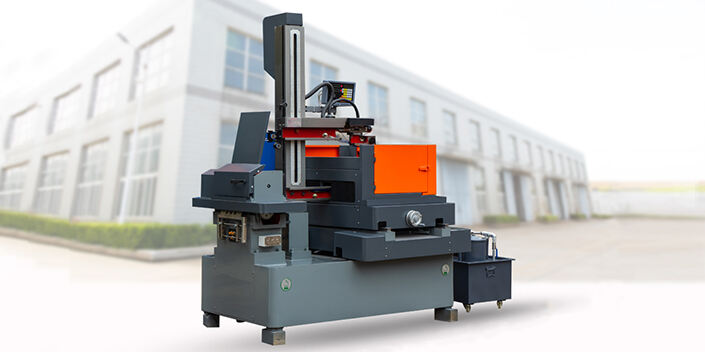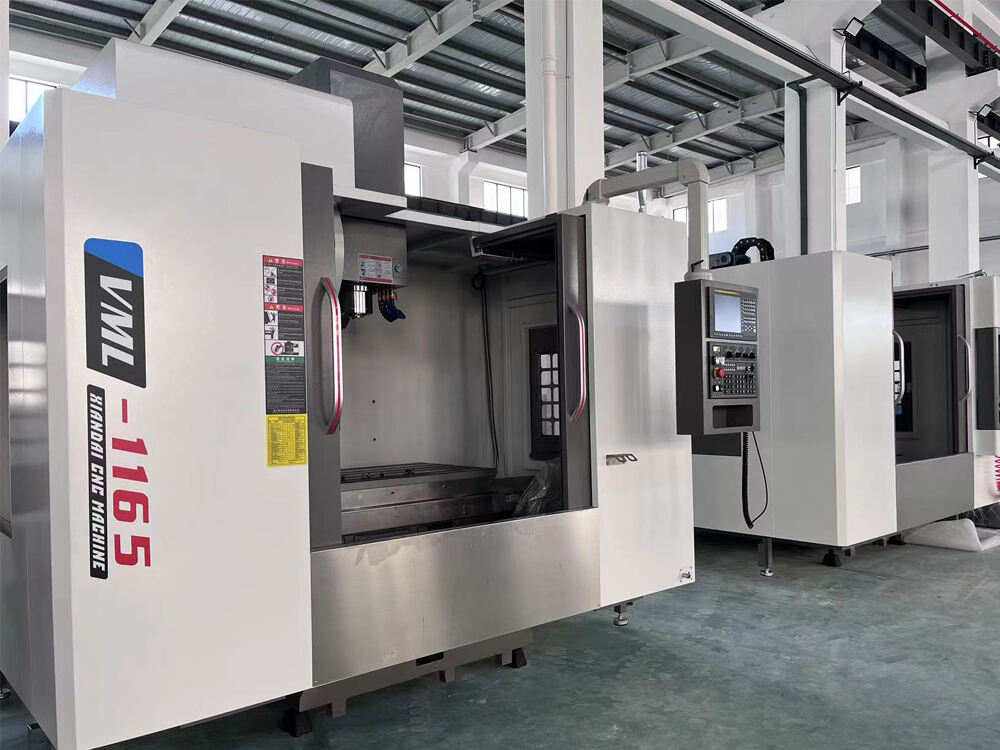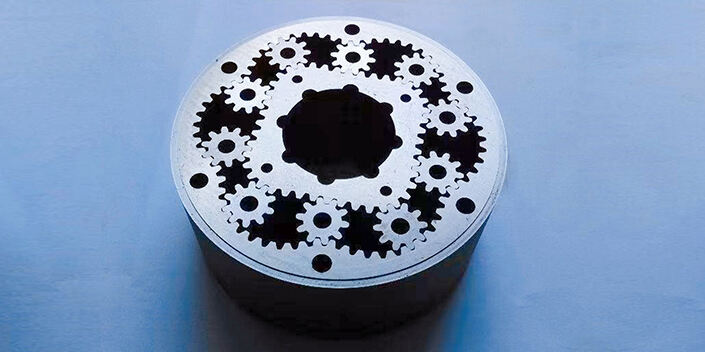How EDM Die Sinking Machines Enable Complex Mold Fabrication
EDM die sinking machines are really good at making complex shapes in tough materials like hardened tool steel, titanium, and tungsten carbide using that spark erosion technique. What makes them stand out compared to regular milling or drilling? Well, they can actually produce those razor sharp inside corners that go down to just 0.1 mm radius, along with deep ribs and tiny features needed for things like medical devices and turbine blades in aircraft engines. Most shops use either graphite or copper electrodes to copy these fine details throughout their production batches, maintaining an accuracy of about plus or minus 5 microns from one piece to the next.
Core Working Mechanism of Electrical Discharge Machining
The process submerges the electrode and workpiece in dielectric fluid, generating 10,000–50,000 sparks per second that vaporize material at 8,000–12,000°C. Voltage (50–300V) and discharge duration (2–200 µs) are precisely adjusted to remove 0.02–0.5 mm³ of material per spark while maintaining surface roughness (Ra) between 0.1–0.4 µm.
Case Study: Application in Automotive Mold Manufacturing
A 2023 CAM Resources analysis demonstrated how sinker EDM reduced lead times by 34% for high-pressure aluminum die-casting molds used in electric vehicle battery housings. The process achieved 15 µm dimensional consistency across 8-cavity tools, eliminating manual polishing and reducing scrappage from 12% to 0.8%.
Why Precision Matters in Modern Molding with EDM Die Sinking Machines
Tolerances tighter than ±0.01 mm prevent flash formation in injection-molded connectors and ensure hermetic seals in microfluidic devices. Unlike CNC machining, EDM induces no residual stresses that could warp thin-walled molds during heat treatment—a critical factor for optical lens production requiring <0.005 mm wavefront distortion.
Poor Surface Finish in EDM Parts: Causes and Corrective Actions
Surface roughness exceeding 0.5 µRa in EDM die sinking machines often stems from mismatched electrical parameters and thermal stress. While EDM typically achieves finishes between 0.15–0.2 µRa under optimal conditions, deviations in process variables can quadruple surface irregularities. Let's examine critical failure points and data-backed solutions.
Thermal Effects and Cracking as Primary Contributors to Rough Surfaces
The rapid heating and cooling that happens during discharge erosion can push local temperatures past 12,000 degrees Celsius, which leads to those pesky micro-cracks and recast layers forming. According to some recent findings from last year, when the dielectric fluid isn't flushed properly, it actually makes things worse by increasing thermal stress. This often results in cracks going down over 15 micrometers deep in hardened tool steel parts. When flushing is done poorly, conductive sludge builds up over time and causes these unwanted secondary discharges that end up pitting surfaces. Industry data indicates that about two thirds of all thermal issues seen in automotive molds come down to simply not having enough dielectric flow rate throughout the process.
Impact of Improper Power Settings and Electrical Parameter Optimization
| Parameter | Optimal Range | High-Risk Range | Surface Impact |
|---|---|---|---|
| Peak Current | 4–8 A | >12 A | Crater depth ↓ 40%, Ra ↓ 0.3 µ |
| Pulse Duration | 50–100 µs | <20 µs | Unstable arcs, uneven erosion |
| Off-Time | 30–50 µs | <15 µs | Incomplete debris evacuation |
Exceeding these thresholds increases arc concentration, creating overlapping craters that degrade surface integrity.
Role of Discharge Pulse Settings in Maintaining Surface Integrity
Fine-tuning pulse intervals proves critical. Increasing off-time by 25% reduces surface roughness by 0.12 µRa by allowing proper dielectric fluid deionization. A 2024 experiment with tungsten carbide molds demonstrated that 3-stage pulse modulation decreased crack density by 37% compared to single-pulse setups.
Solutions for Preventing Surface Defects Using Fine Finishing Cycles
Implement multi-stage machining:
- Roughing Phase: Remove 95% material with 10 A current
- Semi-Finishing: Reduce to 6 A, Ra 0.8 µ
- Finishing: 2 A current with 0.5 mm/s feed rate, achieving Ra ≠ 0.2 µ
This approach, combined with real-time dielectric pressure monitoring, reduces polishing time by 60% in aerospace component production.
Dielectric Fluid and Flushing Issues in EDM Die Sinking Machine Operations
Poor Flushing Leading to Sludge Deposition During EDM Process
Poor circulation of dielectric fluid is one of the main reasons why sludge builds up during EDM die sinking operations. If the flushing pressure drops below what's needed (usually between 0.5 and 2.0 bar depending on application), those tiny bits of eroded metal just sit there in the spark gap instead of getting flushed out. What happens next? Well, industry data shows three big problems when this occurs. First, secondary discharges happen which mess with the machining tolerances. Second, surfaces end up looking rough because particles settle back down on them. And third, electrodes wear out much faster than they should. Take mold manufacturing for example - around a third of all surface pitting defects come from sludge buildup due to inadequate flushing, per recent 2023 reports on machining efficiency. The good news is newer equipment tackles these issues with smart pressure adjustments and moving electrodes that break apart particle clusters before they can cause damage.
Use of Improper or Unfiltered Dielectric Fluid Affecting Performance
When the wrong type of dielectric fluid gets used because it doesn't match up with required viscosity levels or conductivity specs, the whole electrical discharge process starts acting up. Most shops still stick with hydrocarbon based oils for die sinking EDM work since they handle sparks pretty well while keeping particles suspended in the fluid. But there's a big problem when stuff like carbon buildup or tramp oil gets into the mix from poor filtration systems. According to research published in Machining Dynamics Journal back in 2022, these contaminants can actually cut down on dielectric strength somewhere around 18 to 22 percent. What does this mean practically? Spark gaps become unpredictable and we end up seeing heat related damage not just on the parts being machined but also on the electrodes themselves.
Oil Flushing and Working Fluid Management for Consistent Results
Optimizing dielectric performance requires:
- Flow rate calibration: 1.5x material removal rate for hardened steels
- Multi-stage filtration: 5–10 µm particle capture to maintain fluid integrity
- Temperature control: 25–35°C operating range to prevent viscosity shifts
Secondary Discharge Caused by Inadequate Flushing and Its Impact
Residual conductive debris can bridge the spark gap and cause parasitic discharges that hit areas they shouldn't touch. This happens quite often actually and leads to dimensional issues around 0.05 to 0.15 mm in those automotive mold cavities. What makes it worse is these unexpected arcs create intense heat spots sometimes reaching over 12,000 degrees Celsius, which really takes a toll on the hardened tool steel's strength. Regular fluid maintenance checks every 250 to 300 hours of machine operation helps prevent such problems from occurring. Plus, keeping fluids clean extends how long electrodes last before needing replacement, typically giving an extra 40% life out of them according to industry experience.
Dimensional Inaccuracy Due to Spark Gap and Calibration Errors
Overcut, Tool Wear, and Material Removal Rate Dynamics Affecting Tolerances
EDM die sinking machines work through controlled spark erosion for those tight tolerances, though there's always the problem of overcut where sparks go beyond what they should, causing all sorts of dimensional issues. When these tools get worn down from long runs, the spark gap tends to widen somewhere between 0.03 to 0.08 mm according to most industry standards, which naturally makes cavities bigger than intended. Getting the right balance with material removal rate matters a lot here. Pushing for faster removal speeds things up production wise, sure, but it also wears out tools quicker and creates more heat related distortions. This can really mess with accuracy, sometimes dropping it as much as 12 percent when dealing with complicated shapes and features.
Calibration Drift and Electrode Corrosion in Discharge Machining
Looking at calibration practices in 2024 showed something interesting - around one third of all dimensional errors actually come from environmental issues such as changes in temperature or vibrations that throw off machine alignment. The problem gets worse with electrode corrosion too, especially during work with tough materials like hardened steel or carbides. When these tools start breaking down, they create wider spark gaps without warning, making everything even less accurate. Some research into how to maintain precision suggests that keeping workspace temperatures stable can cut down on calibration problems by roughly twenty two percent for those really precise EDM operations. Shops dealing with tight tolerances are starting to take notice of this finding.
Strategies for Compensating Spark Gap Variation Across Conductive Materials
To mitigate spark gap inconsistencies:
- Use adaptive control systems to dynamically adjust voltage based on real-time tool wear feedback
- Apply material-specific offset values (e.g., +0.015 mm for graphite electrodes vs. +0.008 mm for copper)
- Schedule in-process measurements every 15–20 machining cycles using touch probes
Addressing the Gap Between High Precision Claims and Real-World Deviations
While EDM die sinking machines promise ±0.005 mm accuracy, practical results often vary due to cumulative tool wear and dielectric fluid contamination. Manufacturers achieve <0.01 mm consistency by:
- Recalibrating Z-axis positioning daily
- Replacing electrodes after 15–20 hours of continuous use
- Implementing automated gap monitoring with infrared sensors
Regular maintenance cycles reduce dimensional outliers by 60%, bridging the divide between theoretical precision and production-floor realities.
Electrical Instability: Preventing Short Circuits and Arcing in EDM Processing
EDM Pitting and DC Arcing from Unstable Discharges in Mold Manufacturing
When EDM die sinking machines experience unstable electrical discharges, they tend to leave behind problems like surface pitting or DC arcing, especially while working on those complicated automotive molds that manufacturers love to hate. What happens is pretty straightforward really – if the servo control system can't keep those spark gaps just right, then all sorts of wild discharges start happening and end up eating away at parts they shouldn't touch. According to some research published in 2022 by the International Journal of Advanced Manufacturing Technology, around one third of all mold defects actually come from this kind of uncontrolled arcing when doing detailed work. That's a serious number for shops trying to hit their quality targets without blowing through budgets on rework.
Common Troubleshooting Techniques to Prevent Arcing During EDM
Operators mitigate arc-related defects through three key strategies:
- Maintaining dielectric fluid conductivity below 5 µS/cm to prevent secondary discharges
- Implementing pulsed power supplies with <5% current fluctuation
- Using adaptive pause durations between discharge cycles
Regular calibration of voltage monitoring systems helps maintain stable spark gaps, as contaminated dielectric fluids account for 72% of arc-initiated tooling failures (Precision Engineering Society, 2023).
Challenges in Aligning Electrical Parameters with Conductive Materials
Getting the right discharge settings matched to how conductive different materials are still poses quite a challenge for many shops. Copper electrodes typically give around 0.8 to 1.2 microns finish on steel molds, but when working with graphite tools on titanium alloys, operators need to crank up the voltage by about 15 to maybe even 20 percent to get similar results. Because these differences can be so significant, especially when there's more than 40% variation in conductivity according to the International Annealed Copper Standard measurements, most experienced technicians know they have to run real time impedance tests whenever they switch from one material to another. Otherwise, the whole process just doesn't work as intended.
Adaptive Control Systems for Real-Time Arc Suppression
Today's EDM systems come equipped with machine learning algorithms that look at those discharge waveforms sampled at around 10 MHz. When these smart systems spot signs of an impending arc, they can tweak the pulse intervals in just 50 microseconds flat. This quick response cuts down on arcing problems by nearly 90 percent when compared to older methods that relied solely on voltage measurements according to a study from Advanced Manufacturing Review last year. And let's not forget about thermal compensation modules either. These components work against electrode expansion issues, keeping things pretty much spot on with plus or minus 2 micrometers of accuracy even after hours of continuous machining operations without letting precision slip away.
FAQ Section
What is an EDM die sinking machine?
An EDM die sinking machine uses electrical discharge machining to create complex shapes in hard materials like steel and titanium by spark erosion, making it ideal for precision part fabrication.
What are the main advantages of using EDM die sinking machines?
EDM die sinking machines offer the ability to produce complex shapes with tight tolerances, such as deep ribs and sharp inside corners, without inducing residual stresses that can warp the material.
Why is dielectric fluid important in EDM machining?
Dielectric fluid insulates sparks and cleans debris during EDM machining. Its proper circulation and maintenance help in ensuring precise machining and extending tool life.
How can surface roughness issues in EDM be corrected?
Surface roughness issues can be addressed by optimizing electrical parameters, improving dielectric fluid flushing, and implementing multi-stage machining cycles for fine finishing.
How do EDM machines maintain accuracy in precision molding?
EDM machines maintain accuracy by recalibrating tools and maintaining proper dielectric fluid conditions, using adaptive control systems, and conducting regular machine maintenance.
Table of Contents
- How EDM Die Sinking Machines Enable Complex Mold Fabrication
- Core Working Mechanism of Electrical Discharge Machining
- Case Study: Application in Automotive Mold Manufacturing
- Why Precision Matters in Modern Molding with EDM Die Sinking Machines
- Poor Surface Finish in EDM Parts: Causes and Corrective Actions
- Dielectric Fluid and Flushing Issues in EDM Die Sinking Machine Operations
- Dimensional Inaccuracy Due to Spark Gap and Calibration Errors
- Electrical Instability: Preventing Short Circuits and Arcing in EDM Processing
- FAQ Section





